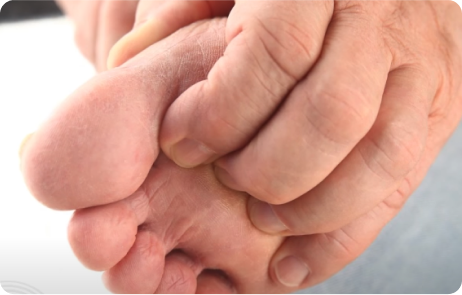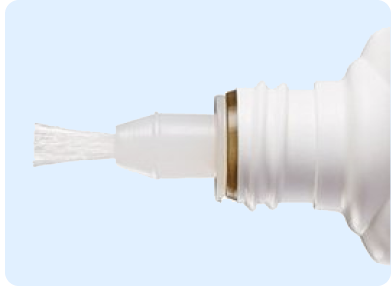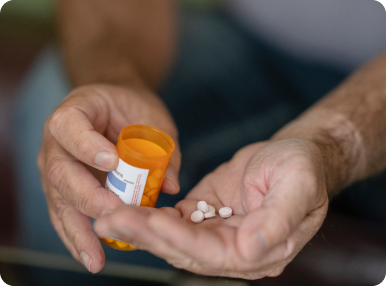Toenail fungus can be treated
Nail infections usually won’t go away on their own, but treatment options are available. It’s important to see a healthcare professional who will suggest the treatment that is best for you.
Both prescription and non-prescription (over-the-counter) treatment options are available for treating toenail fungus (onychomycosis) infections.
Prescription Options
A toenail fungus infection is a real health issue.
Jublia® (Efinaconazole)
Topical
Topical
Liver Toxicity Potential
NO
Drug Interactions
N/A
Available since
2014
Jublia contains efinaconazole 10% in a clear solution for topical application. Jublia is a prescription medicine to be applied to the toenail.
Common Side Effects
Skin irritation around the toenail, such as redness, itching, burning or stinging in the surrounding skin.
ASK A HEALTHCARE PROFESSIONAL
Drug Interactions
Topical administration of Jublia (efinaconazole topical solution, 10% w/w) has very low systemic exposure. Therefore, potential interactions between Jublia and other drugs have not been evaluated.
There are no drug-food, drug-herb, or drug-laboratory interactions that have been established. Studies have not been done.
ASK A HEALTHCARE PROFESSIONALPenlac® (Ciclopirox)
Topical
Topical
Liver Toxicity Potential
NO
Drug Interactions
N/A
Available since
2004
Penlac (ciclopirox topical solution, 8% w/w) is available as a nail lacquer. Penlac is a prescription medicine used as part of a treatment program for fungal infections of the nails (onychomycosis), that includes regular removal of the infected nail as well as daily treatment with Penlac.
Common Side Effects
Skin redness around the nail, shape change, irritation, ingrown toenail and discolouration, application site reaction, burning sensation, dry skin, and itching.
ASK A HEALTHCARE PROFESSIONAL
Lamisil® (Terbinafine)
Oral
Oral
Liver Toxicity Potential
YES
Drug Interactions
YES
Available since
1993
Lamisil (terbinafine) is an oral prescription medication available as 250 mg tablets. Lamisil is used to treat fungal infections of the nail (toes, fingers).
Common Side Effects
Headache, nausea, mild abdominal pain, stomach discomfort after a meal (heartburn), diarrhea, swelling or bloating (a feeling of fullness) of the abdomen, loss of appetite, skin rashes (itchy), joint and muscle pain, mood disorder (depression), loss or disturbance of taste, dizziness, eye disorder, and tiredness. In rare cases, Lamisil can cause abnormal liver function test results. In very rare cases, Lamisil can cause decrease in certain types of blood cells, psoriasis-like skin eruptions (rash with silver coloured appearance), worsening of psoriasis, skin rash with flaking or peeling, and hair loss. Stop taking Lamisil tablets and consult your doctor immediately should you develop jaundice (yellowing of skin and/or eyes).
ASK A HEALTHCARE PROFESSIONAL
Drug Interactions
The following are medications that may interact with Lamisil:
- Some antibiotics (e.g., rifampicin)
- Some antidepressants (e.g., tricyclic antidepressants, selective serotonin reuptake inhibitors, including class 1A, 1B and 1C, monoamine oxidase inhibitors Type B, and desipramine)
- Some medicines used to treat irregular heart rhythm called “antiarrhythmics” (e.g., propafenone and amiodarone)
- Some medicines used to treat high blood pressure (e.g., beta-blockers such as metoprolol)
- Some medicines used to treat coughs (e.g., dextromethorphan)
- Cyclosporine, used to control the immune system and prevent transplant rejection
- St. John’s wort (Hypericum perforatum), a herbal medicine used to treat depression
Sporanox® (Itraconazole)
Oral
Oral
Liver Toxicity Potential
YES
Drug Interactions
YES
Available since
1993
Sporanox (itraconazole) is an oral medication available in 100 mg capsules and is used to treat fungal infections.
Common Side Effects
High triglyceride and liver tests, nausea, bloating, diarrhea, upset stomach, vomiting, abdominal pain, constipation or excess stomach gas, altered voice, inflammation of the sinuses, inflammation of the nose, upper respiratory tract infection, headache, dizziness, menstrual disorders, erectile dysfunction, confusion, tremors, sleepiness, fatigue, chills, muscle weakness or pain, painful joints, chest pain, swelling, generalized swelling, unpleasant taste, hair loss, inflammation of the pancreas, fever or excessive sweating. Uncommon but possible side effects include heart, liver, and nerve problems, hypersensitivity, severe skin disorder, blurry or double vision, tinnitus, photosensitivity, urinary incontinence, and hearing loss symptoms.
ASK A HEALTHCARE PROFESSIONAL
Drug Interactions
A wide variety of drugs may interact with Sporanox capsules. Never take Sporanox capsules if you are taking any of the following medications:
- Boosted asunaprevir used in the treatment of Hepatitis C Virus
- Eplerenone, felodipine, ivabradine, ranolazine used to treat angina (crushing chest pain) or high blood pressure
- Ticagrelor, apixaban, rivaroxaban used to slow down blood clotting
- Lomitapide, lovastatin, simvastatin which lower cholesterol
- Triazolam, sleeping pills
- Lurasidone, pimozide used for psychotic disorders
- Methadone for severe pain or to manage addiction
- Dihydroergotamine or ergotamine (called ergot alkaloids); used in the treatment of migraine headaches
- Ergometrine (ergonovine) (called ergot alkaloids) used to control bleeding and maintain uterine contraction after childbirth
- Eletriptan used to treat migraine headaches
- Irinotecan, an anti-cancer drug
- Disopyramide, dronedarone, quinidine, used to treat irregular heartbeat rhythms
- Domperidone used to treat nausea and vomiting
- Isavuconazole; to treat fungal infections
- Naloxegol; to treat constipation caused by taking opioid painkillers
- Eliglustat to treat Gaucher disease type 1 (GD1)
- Colchicine, used to treat gout*
- Fesoterodine or solifenacin when used to control irritated urinary bladder*
- Venetoclax†
Other medications may also interact with Sporanox. This is not a complete list.
* If you have kidney or liver problems, do not take Sporanox capsules while taking these medicines.
† Do not take these medicines while you are on Sporanox capsules, if you have chronic lymphocytic leukemia/small lymphocytic lymphoma and you want to newly start this medicine or are making dose adjustments.
Lifestyle and non-prescription options
Other ways to treat a toenail fungus infection include lifestyle changes and non-prescription or over-the-counter medicines. Being active can increase your risk of getting toenail fungus, but there are things you can do in your daily life to lower that risk. For example, you can wear shoes that let your feet breathe, change your socks often, and keep your feet clean and dry.
Please note that some of the non-prescription medicines below are to treat other types of foot fungus, and not specifically toenail fungus infections.
EMTRIX®
Topical
Topical
Active Ingredient(s)
CARBAMIDE (UREA),
LACTIC ACID
Use
NAIL FUNGUS INFECTION
Emtrix is available as a solution to help treat localized fingernail and toenail infections. It helps reduce the growth of certain fungi known to cause fingernail and toenail infections.
Treatment Considerations
Transient minor irritation to the skin next to the affected nail can occur; if irritation worsens or persists, stop use and consult a healthcare professional. Harmless discolouration (whitening) of the affected nail may occur. In rare cases, the affected nail may become loose and detach from the nail bed. If this occurs, stop use and consult a healthcare professional.
ASK A HEALTHCARE PROFESSIONALEXCILOR® EXCILOR FORTE
Topical
Topical
Active Ingredient(s)
ACETIC ACID
Use
FUNGAL NAIL BED INFECTION
Excilor and Excilor Forte are liquid formulas used to help treat infection by changing the pH level inside the nail, which creates a hostile environment for fungi.
Treatment Considerations
Do not use if you are pregnant or breastfeeding. In the case of Excilor Forte, burning sensation, itching or mild, localized pain may occur.
Consult a healthcare practitioner if symptoms persist or worsen. In the case of diabetes, consult your doctor regularly if you have foot problems.
ASK A HEALTHCARE PROFESSIONALFUNGI NAIL®
Topical
Topical
Active Ingredient(s)
10-UNDECENOIC ACID, ZINC SALT
Use
ATHLETE'S FOOT, RINGWORM
Fungi Nail is an ointment used to relieve itching, burning and cracking associated with athlete’s foot and ringworm.
Treatment Considerations
This product is not effective on the scalp or nails. If irritation occurs or there is no improvement within 4 weeks, stop use and contact a doctor. Do not use on children under 2 years of age unless directed by a doctor.
ASK A HEALTHCARE PROFESSIONALFUNGICURE®
Topical
Topical
Active Ingredient(s)
UNDECYLENIC ACID
Use
ATHLETE'S FOOT, RINGWORM
Fungicure’s liquid formulation is used for the cure of ringworm and athlete’s foot on the fingers and toes. It also relieves the associated irritation, redness, itching, scaling, cracking, burning, discomfort and soreness.
Treatment Considerations
This product is not effective on the scalp or nails. Do not use for the infection of the scalp. If irritation occurs or if there is no improvement within 4 weeks, stop use and consult a doctor. Persons under 18 years of age or those with highly sensitive or allergic skin should use only as directed by a doctor. Do not use on children under 2 years of age unless directed by a doctor.
ASK A HEALTHCARE PROFESSIONALFLEXITOL®
Topical
Topical
Active Ingredient(s)
UNDECYLENIC ACID
Use
ATHLETE'S FOOT
Flexitol is a liquid treatment for athlete’s foot. It also relieves the associated skin itching, scaling, cracking, burning, redness, soreness and irritation.
Treatment Considerations
Do not use for infection of the nails. If irritation occurs or there is no improvement within 4 weeks, stop use and contact a doctor. Do not use on children under 2 years of age, except on the advice of a doctor.
ASK A HEALTHCARE PROFESSIONALPhysical and light treatments
A healthcare provider may remove parts of an infected toenail or even the entire toenail. This won’t get rid of the fungus, but it can help the topical medicines reach the infected area better.
Lasers, photodynamic therapy and diode lasers are some relatively new treatments that may help to treat toenail fungus. However, at this time, research tells us that laser treatment may not work very well on its own to treat fungal nail infections.
Toenail fungus infections can be hard to treat because of the time it may take for proper treatment, as well as the time needed for the toenails to regrow.
Home remedies for toenail fungus
You may see lots of advertisements for toenail fungus home remedies on the Internet. But are they effective?
Watch the video to find out

Reality Check
It's important to have realistic expectations about treatment
Before starting treatment, talk to a healthcare professional. They can tell you what kind of results to expect, how long treatment may take and possible side effects. If you expect too much too soon, you might feel disappointed and stop using the treatment the way your healthcare provider has asked you to.
Some evidence tells us that using more than one kind of treatment together may help you get better results. It may also help to stop the toenail fungus coming back. This is why a healthcare professional may suggest both topical and oral treatment, or both topical and physical treatment, to increase your chances of a cure.
A toenail fungus infection takes time to treat
While prescribed medicines are effective, it takes time to cure a toenail fungus infection. Even after the fungus is gone, your damaged nail will not look normal until it grows out and is replaced by the healthy nail. Remember that nails grow slowly! Even though the medicine is working, it can take 12 to 18 months for toenails to regrow completely.
These are medicines which are usually applied directly to the affected nails. They have a local effect, which means they work on the fungi in the nail and nail bed. Because your body only absorbs or takes in a small amount of the medicine, it usually doesn’t affect other medicines you're taking. Side effects are usually mild and only happen to the area that you apply the medicine to.

These are treatments you take by mouth, like a pill. Oral treatments are carried by the blood stream to the nail bed without needing to get past the tough nail plate. Since your whole body absorbs or takes in the medicine, oral treatments can affect other medicines you take and harm your liver. This is why your healthcare provider may regularly check your liver function when you take oral antifungal medicine.
